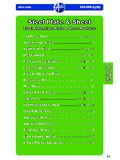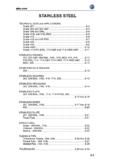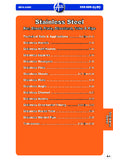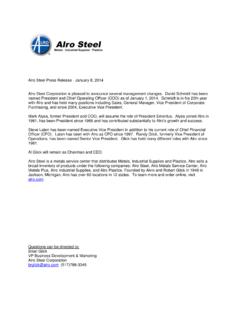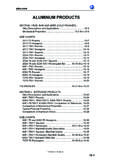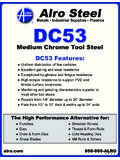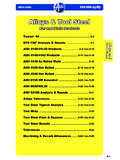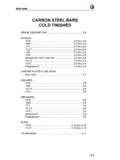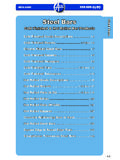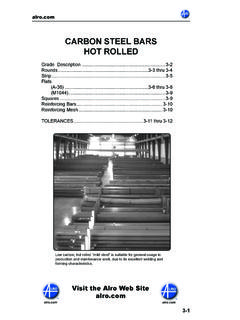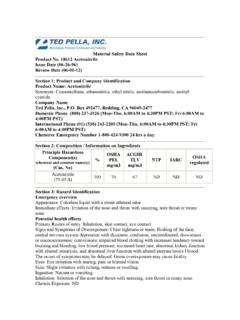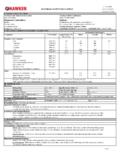Transcription of SAFETY DATA SHEET ABS SHEET - Since 1948
1 SAFETY data SHEET . ABS SHEET . SECTION 1: IDENTIFICATION. Product Name: King KPC ABS. Product Number: ABS-[NUMBERCODE] [ , NUMBERCODE = COLOR, SURFACE, GAGE, WIDTH-LENGTH]. Physical State: Solid Color: Natural processed color is translucent to opaque white (Colorants can be added). Odor: Faint to mild odor. Type of Use: Fabricated ABS Products FDA Status: No Company Business / Emergency Contact King Plastic Corporation 1100 N. Toledo Blade Boulevard North Port, FL 34288 | Tel. 941-493-5502. SECTION 2: HAZARD(S) IDENTIFICATION. Classification of Hazards While in normal usage form, this material does not meet or exceed requirements to be classified as a hazardous chemical in accordance with the GHS aligned OSHA Hazardous Communication Standard Appendix A, and Appendix B.
2 However, when subjected to processing methods that increase the material temperature, or result in production of material dusts, certain precautions become necessary. Signal Word and Precautionary Statement (Non-mandatory). CAUTION! Product is a clear to white, non-toxic solid SHEET material having minimal odor. Dusts and heat-released air emissions may be irritating to the eyes, skin, and respiratory system. Under fire conditions, product will readily burn and emit a heavy, irritating smoke. Contact with molten material may cause serious thermal bums. Identification Symbols or Labels Not Applicable Potential Health Effects Eyes: If there is contact to the eyes with molten material , rinse with plenty of water and seek immediate medical attention.
3 If fines enter the eye, rinse with water for 15 minutes and seek immediate medical attention if irritation develops. Skin: If skin has contact with molten material , place affected area under cold running water. Seek medical attention for removal of material from the affected area. Ingestion: Ingestion of this product is unlikely. However, ingestion of product may produce mild gastrointestinal irritation and disturbances. Inhalation: Remove affected individual to fresh air, seek medical attention if difficulties in breathing occur Environmental Hazards: ABS is an essentially biologically inert solid and considered non-toxic. It is stable (does not decompose) in landfills or in aquatic systems.
4 SECTION 3: COMPOSITION/INFORMATION ON INGREDIENTS. Chemical Name: Acrylonitrile/Butadiene/Styrene Common Name: ABS. Component Percent CAS #. by Wt. Acrylonitrile/Butadiene/Styrene >=99% 9003- 56- 9 Additives* 0-1% N/A. SECTION 3: COMPOSITION/INFORMATION ON INGREDIENTS Cont. Additional Information * Other chemical additives including antioxidants, UV stabilizers, processing aids and slip agents may be formulated into various polyethylene resin grades in a total concentration of less than 1% wt. /wt. Trade Secret(s) Compositions given are typical values not specifications. Identity of Resin Manufacturers, Additive Component. Manufacturers and exact percentage of blends are proprietary information.
5 SECTION 4: FIRST AID MEASURES. Eyes: Remove contact lenses, if it can be done safely. Immediately flush eyes with water for at least 15. minutes, while holding eyelids open. Seek medical attention if symptoms develop or persist. Skin: Remove dusty or contaminated clothing and shoes. For skin contact, wash affected area with soap and water. Seek medical attention if symptoms develop or persist. In case of contact with molten product, cool rapidly with water and seek immediate medical attention. Do not attempt to remove molten product, or molten product that has cooled, from skin without medical assistance. Inhalation: Move affected individual to non-contaminated air.
6 Loosen tight clothing such as a collar, tie, belt or waistband to facilitate breathing. Seek immediate medical attention if the individual is not breathing, is unconscious or if any other symptoms persist. Inhalation of smoke following a fire may result in delayed pulmonary edema; seek immediate medical attention. Ingestion: material is not expected to be absorbed from the gastrointestinal tract. DO NOT INDUCE. VOMITING. Loosen tight clothing such as a collar, tie, belt or waistband. Seek immediate medical attention. Notes to Physician: After adequate first aid, no further treatment is necessary, unless symptoms reappear. Burns should be treated as thermal burns.
7 Molten resin will come off as healing occurs; therefore, immediate removal from the skin is not necessary. Treatment should be directed at the control of symptoms and the clinical condition of the patient. Ingested material should pass through the digestive system without injury. SECTION 5: FIRE FIGHTING MEASURES. Suitable extinguishing media: Water mist, dry chemical, carbon dioxide, or appropriate foam. Extinguishing media which must not be used for SAFETY reasons: - Special exposure hazards arising from the substance or preparation itself, combustion products, resulting gases: During a fire, combustion products including but not limited to Carbon monoxide, Carbon dioxide, Hydrogen Cyanide, Styrene, Ethylbenzene and Acrylonitrile may be emitted.
8 Special protective equipment for fire-fighters: Use self-contained breathing apparatus. Use water spray to keep fire-exposed containers cool. Dust is not expected to be generated in the event of a fire. SECTION 6: ACCIDENTAL RELEASE. Personal Precautions / Protective Measures: Slipping Hazard, avoid standing or walking on product, or product debris. For product debris: Do not use compressed air to sweep debris. Eliminate sources of ignition. (No smoking, flares, sparks or flames in immediate area). Dissipate static electricity during transfer or processing by use of proper electrical grounding and bonding methods. Equipment and Emergency Procedures: (Use ERG Guide #133 in event of fire) For debris spill, isolate area for at least 25 meters (75 feet) in all directions, if no fire exists.
9 In case of Fire: Keep unnecessary personnel away and notify emergency and firefighting personnel. If tank, rail car or tank truck is involved in a fire, ISOLATE for 800 meters (1/2 mile) in all directions; also, consider initial evacuation for 800 meters (1/2 mile) in all directions. Stay upwind from fire. Environmental Precautions: Prevent entry of small debris into ditches, sewers, and waterways. Plastic pellets, and debris are defined by the UA EPA under the Clean Water Act (40 CFR ) as a Significant material , which requires any industrial plant that may expose pellets to storm water to secure a storm water permit. Pellets or debris found in storm water runoff are subject to EPA regulations with the potential for substantial fines and penalties.
10 Use appropriate tools to put the spilled solid in an appropriate disposal or recovery container. Reuse or recycle where possible. Methods and Materials for Containment and Cleaning Up Spills: Wear appropriate protective equipment and clothing during cleanup. Vacuum or sweep material into container, do not use compressed air to sweep debris material . Other Information: Risk of dust-air explosion is increased if flammable vapors are also present. SECTION 7: HANDLING AND STORAGE. Handling Procedures: SHEET material : Secure product to prevent shifting during handling, or transport. Debris: Handle in contained and properly designed equipment systems. Avoid ingestion and inhalation.
